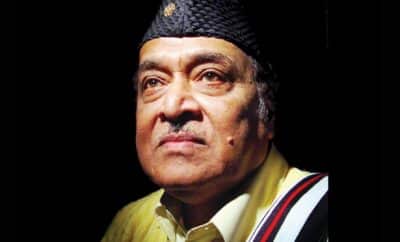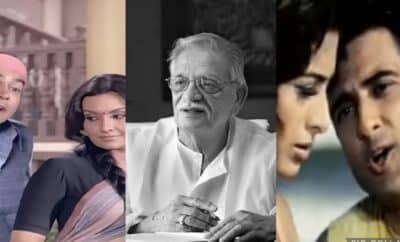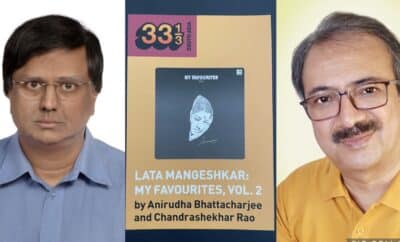Collections
Rare Gems in the Empress’s Crown – Lata Mangeshkar and Forgotten Composers – Part 2
In furtherance of – Rare Gems in the Empress’s Crown – Lata Mangeshkar and Forgotten Composers – Part 1, let us summarily look at Lata Mangeshkar’s work with a few more forgotten / lesser known composers whose contribution in her repertoire, albeit quantitatively far less, was no less in terms of quality than their celebrated compeers.
Master Krishnarao – Aaj Milan Ki Raat Hai
Master Krishnarao (born as Krishnarao Phulambrikar near Pune in a Maharasthrian family) was a renowned classical vocalist, theatre actor and theatre and film composer in the pre-independence era. He was known for his expertise in Khayal and Thumri tradition and also for creation of a few new raags by combining features of different existing raags. He was awarded Padma Bhushan in 1971 for his contribution to classical music.
Though this may be a forgotten or an altogether unknown name for the people outside Maharashtra, the name is remembered with utmost reverence by the lovers of vintage and classical music in Maharashtra. He composed music for and acted in several plays of the revolutionary theatre actor and singer Baal Gandharva from the 1910s to the early 1930s. His first film as a composer was the Marathi film Dharmatma (1935), which was produced by Prabhat Film Company (owned by V. Shantaram with other partners) with Baal Gandharva as the protagonist. He then went on to compose the soundtracks of many Marathi and Hindi films mainly under the banner of Prabhat Film Company during the 1930s and the 1940s. He was seen in fits and starts in the film music thereafter.
His music for the film Keechak Vadh (1959) is equally loved by the lovers of classical music and Marathi Natya Sangeet (a genre of semi-classical music in Marathi theatre), as well as the lovers of light music. The film, based on a mythological story (a part of Mahabharata) was made in Marathi and Hindi simultaneously and Master Krishnarao had composed both the soundtracks.
Among all the dulcet songs in the film, the conspicuous Lata solo “Aaj milan ki raat hai” sticks out. It is an enticing call by Draupadi to lure Keechak into the death trap, as the vindictive Bheem is clandestinely waiting to pounce upon and kill him for mistreating Draupadi in the royal court. A pleasant tune supported by sitar, flute, violins and Hawaiian guitar, Bharat Vyas’s apt words and Lata Mangeshkar’s gratifying rendition make this song a perfect dessert for ears.
The Marathi version of this song (“Dhunda madhumati raat re”) is held dear by the Marathi music lovers across generations, even today.
https://www.youtube.com/watch?v=0SIOaIbL84E
Vinod – Kaga Re Ja Re Ja Re
Vinod (born as Eric Roberts) was one of the Punjabi composers who shaped up the Hindi film music during the 1940s. Vinod, who hailed from Lahore and was a disciple of Pandit Amarnath (elder brother of the composer duo Husnlal – Bhagatram), started his career with Khamosh Nigahein (1946) and went on to compose songs for more than 30 Hindi and Punjabi films. Many of his compositions were based on Punjabi folk music and marked by rapid rhythm. Nevertheless, Vinod fell short of reaching the pinnacle of commercial success in Hindi films. He died in a miserable state just at the age of 37 with the sour taste that the lack of success would have left in his mouth.
His association with Lata Mangeshkar started with his Punjabi film Chaman (1948) and later they created many peppy as well emotional songs together mainly in the late ‘40s. The famous frothy dance number, for which Vinod is mainly remembered to date – “Lara lappa lara lappa laai rakhda” (Ek Thi Ladki, 1949) – is the flagship song of their alliance.
Among the emotional songs that Lata Mangeshkar rendered under his music direction, the soulful number “Kaga re ja re ja re” from Wafa (1950) stands out. Though the soundtrack was the joint work of Vinod and Bulo C. Rani, Vinod has this song solely to his credit. He has woven Aziz Kashmiri’s words in a tune full of pathos. The violin dominated orchestration with slight touches of sitar and piano develops a poignant aura. And the intense rendition by Lata Mangeshkar, who was then in her early blooms, takes the song several notches up.
Mohammed Shafi – O Maalik Kya Tu Bhi Soya
Mohammed Shafi was a well-known music arranger and sitar player in Hindi films. He started his career as an assistant to the music directors in a few New Theatres films in the 1930s. He also worked as assistant music director with one of the doyens of Hindi film music Naushad for 14 years. Haqdar (1946) was his first film as an independent composer. He composed music for more than 15 Hindi films and 2 Marathi films independently and worked with almost all the playback singers of the golden era. However, he remains unsung as a composer and more known as an arranger.
Suman Kalyanpur gave her first Hindi playback for Mangu (1954) under Mohammed Shafi’s baton. Though later O.P. Nayyar replaced Shafi as the composer of the film, out of the 3 songs that Suman Kalyanpur had recorded under Shafi’s music direction, the immortal lullaby “Koi pukare dheere se tujhe” was retained in the film even after Shafi’s replacement.
The soundtrack of Bazooband (1954) composed by Mohammed Shafi has 5 Lata solos; out of which “Bazooband khul khul jaye” is popular. The soundtrack also has another wonderful Lata solo – “O maalik kya tu bhi soya” – a call to the Almighty by a distressed and helpless mother and wife. Chandrashekhar’s words describe the mother’s pain in suitable words. Mohammed Shafi has woven these words in a poignant tune supported by violin dominated orchestration and mesmerising rhythm. He has added a subtle Arabic touch at the end of the first line of each stanza. Lata Mangeshkar’s rendition is drenched in pathos, so much so that you tend to think that she is the only distressed mother.
Nashad – Abke Baras Bada Julm Hua
Nashad (born as Shaukat Hussain Dehelvi) did a fairly good job as music composer during the late 1940s, the 1950s and the early 1960s. He composed music for 29 Hindi films before he migrated to Pakistan in 1964. He gave the first break to Mubarak Begum in Aiye (1949). In spite of numerous good songs that he composed, he was lost in oblivion. His bad luck doesn’t stop just at this. His famous composition “Tasveer banaataa hoon, tasveer nahin banti” sung by Talat Mahmood for Baradari (1955) is credited to the famous music director Naushad in almost every archive.
Nashad is best remembered mainly for his songs in Baradari, which was a Lata dominated soundtrack, including a cheerful number “Abke baras bada julm hua”. The song expresses hitherto unknown feelings springing up in an adolescent girl’s mind on realisation of coming of age. Khumar Barabankwi has penned these feeling in simple words and Nashad has composed a suitable playful tune supported by sitar, flute and dholak. Lata Mangeshkar’s rendition time and again proves that there would not have been a better choice than her for this coltish song. Geeta Bali, on whom the song is picturised, looks as cute as ever.
Manohar – Badi Mushkil Hai, Ajab Mera Dil Hai
Manohar Arora was a Punjabi composer who composed music for a handful of Hindi films under the mononym Manohar. He started his career in Hindi films with Raees 1948. Thereafter, he gave music to a few films in the 1950s and only a couple of films in the 1960s, after which his career in Hindi cinema seems to have come to an end. Playback singer Madhubala Jhaveri sang her first Hindi playback under his baton in the early 1950s. He is often confused with Manoharlal Sonik of the famous composer duo Sonik – Omi.
The soundtrack of Chingari (1955) can be counted as his best work. It has 6 solos by Lata Mangeshkar and one solo each by Talat Mahmood and the heroine of the film Nalini Jaywant. Though all the songs are mellisonant, the Lata solo “Badi mushkil hai, ajab mera dil hai” immediately catches the attention. The heroine is yearning for the love seen in the dreams, which is yet to be seen in reality. Sahir Ludhianvi describes her feelings in simple yet befitting words. Look at the line “Mere sang sang meri nindiya bhi saari raat jage” – only Sahir can be so creative in describing the sleepless nights in love. The pleasant orchestration, the haunting rhythm and Lata Mangeshkar’s nectar-laden rendition create an awesome aroma.
Basant Prakash – Saajan Tumse Pyar Karoon Main
Basant Prakash was the younger brother of one of the veteran composers and pioneers of the Lata Era, Khemchand Prakash. He made his debut in Hindi cinema by taking over the music direction of Jai Shankar (1951) that was left incomplete due to the untimely death of Khemchand Prakash. Then he went on to compose music for a handful of Hindi films in the 1950s and a couple of films in the 1960s, after which his career practically ended.
Filmistan approached C. Ramchandra for the music of Anarkali (1953), with a condition that all the songs would be sung by Geeta Dutt. As he preferred Lata Mangeshkar, he declined and Filmistan signed Basant Prakash, who recorded one song in Geeta Dutt’s voice (“Aa jaan-e-wafaa”). However, soon thereafter, due to his illness (some accounts mention differences with the producer), Filmistan again approached C. Ramchandra and the rest is history. Though Basant Prakash composed mellifluous songs for his films, hardly any of his songs find a place in the memory of the music lovers; and unfortunately he is remembered more for this dramatic loss of the Anarkali assignment.
Badnaam (1952) was one of his fantastic albums having 8 melodic songs, out of which 4 were sung by Lata Mangeshkar. The Lata songs include a cloyingly sweet but forgotten romantic gem “Saaajan tumse pyaar karoon main”. The song portrays the heroine’s sweet hesitation in expressing her love, in the words of Hasrat Jaipuri and Lata Mangeshkar’s adorable rendition in nascent and honeyed voice. Brief pieces of flute appended to Lata Mangeshkar’s lines in refrain add an endearing charm to the composition.
Shailesh – Nadiya Ke Paani O Re Nadiya Ke Paani
Shailesh (Mukherji), though a multifaceted artiste (composer, singer and actor), is an almost forgotten name on the landscape of Hindi cinema, may be due to the very little work that he did there. He composed music only for 3 Hindi films, viz. Suhag Sindoor (1953), Parichay (1954) and Savera (1958). He also acted in a couple of films as a hero under the pseudonym Srikant Gaurav during the 1960s. Though he has composed memorable songs for the aforesaid films, not much information is available about him.
Lata Mangeshkar featured in 8 songs in 2 out of the 3 soundtracks that Shaliesh composed. “Savera” that starred Meena Kumari and Ashok Kumar in the lead roles could arguably be considered as his most remarkable work. The soundtrack of Savera has a melodious song “Nadiya ke paani o re nadiya ke paani”, sung by Lata Mangeshkar and penned by Shailendra. In the song, Meena Kumari is complaining to the river about her childhood lover, who is right in front, but is feigning unfamiliarity. This is a fantastic experiment of composing a brisk paced sad song. Catchy orchestration and Lata Mangeshkar’s saccharine rendition make this song too appealing to forget once you have listened to it.
Ramlal – Pankh Hote To Ud Aati Re
Ramlal Chaudhari, best known as Ramlal, is a lesser seen composer, though he cannot be counted among the forgotten composers. Ramlal started his career as an assistant to the composer Ram Ganguly in Prithvi Theatres. He also played flute and shehnai for several film songs. He got his first break as an independent composer in Taangawala 1950. The film was, however, shelved. His first film that saw the light of the day was Husn Bano (1956). He then composed music for Naqab Posh (1956), Naag Lok (1957) and Maya Machhindra (1960). However, his work went totally unnoticed. He got recognition through his compositions for two movies, Sehra (1963) and Geet Gaya Pattharon Ne (1964), made by V. Shantaram. Though he did not get any further opportunity in spite of the outstanding work for these two films, his music for these films is sufficient enough to make him immortal in the memory of music lovers.
The popular Lata solo from Sehra (1963) – “Pankh hote to ud aati re” – has a catchy tune based on raag Bhupali. Amazing use of jal tarang in the orchestration makes the song more attractive. Lata Mangeshkar’s proficiency becomes evident right from the first aalap and she carries the song extremely well to the end, as usual. Sandhya’s dance seems freehand and impromptu as usual, but is enjoyable. The lyrics are written by Hasrat Jaipuri and the song is picturised in the patent V. Shantaram style.
https://www.youtube.com/watch?v=Qqr-eEY2pNM
Lachhi Ram – Aye Dil Machal Machal Ke Yun
Lacchiram (Tamar) hailed from the princely state of Kuthar in Himachal Pradesh. He was trained in music right from his early years. He was noticed by the lyricist Aziz Kashmiri when he was working with HMV in Delhi and got his first break in films through Champa (1945). Though he composed music for 20 odd films till 1964, his early films could not give him much recognition; even Dev Anand and Madhubala starrer Madhubala (1950) could not help him much. He is remembered mainly for the soundtrack of Razia Sultana (1963), more so for the Asha – Rafi duet “Dhalti jaaye raat, keh le dil ki baat”.
Lata Mangeshkar seems to have sung only one song under his baton – “Aye dil machal machal ke kyun rota hai zaar zaar kya” – in his last film Main Suhagan Hoon (1964). This is a sad song picturised on heart-broken heroine (Mala Sinha). The intense tune is well-supported by Butaram Sharma’s words and beautiful orchestration comprising violins, sarangi, Hawaiian guitar, mandolin and tabla. Lata Mangeshkar has done complete justice to the mood through her touching rendition. How effortlessly and flawlessly she sings in the higher octave in the second stanza!
Shambhu Sen – Sun Man Ke Meet
Shambhu Sen, one of the sons of the composer Jamal Sen (addressed in the first part of this write-up), and brother of Dilip Sen and father of Sameer Sen (the Dilip Sen – Sameer Sen composer duo), was a renowned dance exponent with many celebrity students like Hema Malini, Yogita Bali and Aruna Irani. He composed music only for 2 Hindi films – Mrigtrishna (1975) and Banno (1987), of which the soundtrack of Mrigtrishna is noteworthy and has the songs sung by a battery of renowned singers like Lata Mangeshkar, Asha Bhosle, Mohammed Rafi and Mehdi Hassan. The movie was a box-office flop and consequently its music, howsoever good, could not get the popularity that it deserved.
The Lata solo “Sun man ke meet more prem geet”, an alluring call to the beloved, is a fantastic composition picturised on the heroine Yogita Bali. It seems to have some kind of supernatural aura around it. Shambhu Sen has set his own words to a simple yet euphonious tune and orchestrated it nicely with violins, santoor, sitar and flute. The rhythm of the song captivates you in no time. Lata Mangeshkar (who would have been in her late 40s by then) sounds very young and at the same time as maturely sweet as a naturally ripe fruit. The relatively simple tune calling for few vocal acrobatics would have been a cakewalk for her.
Thanks to today’s technological advancement that we are able to retrieve and savour such then forgotten songs lost in the mists of time.
Again, this is not all about Lata Mangeshkar’s work with forgotten / lesser known composers. When you start thinking about such composers, the memory game seems to be never ending, and the list keeps on only increasing – for example D. Dileep (alias Dileep Dholakia, who later become assistant to Laxmikant – Pyarelal), Ganesh (Pyarelal’s younger brother), Avinash Vyas (a legendary composer in Gujrati music), Vasant Prabhu (doyen of Marathi non-film music) – so on and so forth.
As the list is very long, only a few composers who have composed remarkable songs for Lata Mangeshkar are addressed in the two parts of this write-up. This is of course a matter of personal choice involving a great deal of subjectivity; and one may find compositions of some other forgotten composers better. Also, one blessed with a good memory may think that some of these composers are not forgotten; while for someone else, some other composers not touched upon may be lesser known.
Though none of these composers had a lion’s share in her career, a few golden bricks that they contributed to the edifice of the Empress’s magnificent musical empire cannot be certainly overlooked



